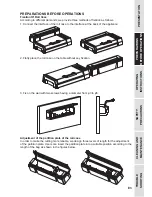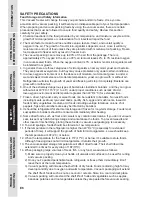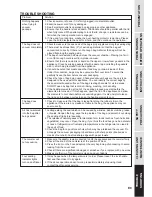
SAFETY PRECAUTIONS
Food Storage And Safety Information
This Vacuum Sealer will change the way you purchase and store foods. Once you are
accustomed to vacuum packing, it will become an indispensable part of your food preparation.
When preparing and vacuum packing foods by using the vacuum sealer, there are certain
procedures that must be followed to ensure food quality and safety. Review this section
carefully for your safety.
1. Chemical reactions in the food generated by air, temperature, and moisture, enzyme action,
growth of microorganisms or contamination from insects will spoil the food.
2. The main factor to make food lose nutritive value, texture, flavor, and overall quality is
oxygen in the air. The growth of most micro-organisms depends on air, since it will carry
moisture into and out of food unless they are protected with moisture-proof packing. Frozen
food exposed to freezer air may result in freezer burn.
3. The vacuum packing can remove up to 90% of the air from the package. There is
approximately 21% oxygen in the air, so 90% air removal leaves 2% to 3% residual oxygen
in vacuum-sealed foods. When the oxygen content is 5% or below, most microorganisms will
be inhibited from growth.
4. In general, there are three categories of microorganisms, namely mold, yeast and bacteria.
They are present everywhere, but they may cause problems only under certain conditions.
5. In a low-oxygen environment or in the absence of moisture, mold cannot grow; in under a
wet and sweet circumstance at moderate temperature, yeast can grow with or without air.
Refrigeration will slow the growth of yeast and freezing will stop it completely; Bacteria can
grow with or without air.
6. One of the extremely dangerous types of bacteria is clostridium botulism, and they can grow
without air at 40°F to 115°F (4° to 46°) under proper conditions such as lack of acid,
low-oxygen environment and temperature greater than 40°F(4°C) for extended time.
7. Frozen, dried, high-acid, salty or sweet foods can be resistant to botulism. Non-acid foods
including meats, seafood, lye-cured olives, poultry, fish, eggs and mushrooms, low-acid
foods mostly vegetables, medium-acid foods including overripe tomatoes, onions, chili
peppers, figs and cucumbers are easy be infected by botulism.
8. It should be refrigerated for short-term storage and frozen for long-term storage. Foods most
susceptible to botulism should be consumed immediately after heating.
9. Some dried foods, such as flour and cereals may contain insect larvae, if you do not vacuum
seal, larvae may hatch during storage and contaminate the foods. To prevent weevils and
other insects from hatching, storing these foods in vacuum seal packaging is necessary.
10. To avoid spoilage, foods should be stored at a 1ow temperature.
11. If the temperature in the refrigerator is higher than 40°F(4°C) (especially for extended
periods of time), it will support the growth of harmful microorganisms, so we should keep
the temperature at 40F(4°C) or below.
12. When the temperature for the freezer is 0°F(-17°C) or below, it's suitable to store foods.
Although freezing does not kill microorganisms, it retards their growth.
13. The vacuum-sealed storage temperature will affect dried foods. Their shelf life will be
extended 3-4 times for every drop of 18F(10°C).
14. When packaging large volumes of meat, fish, or any food, we advise as follows.
1). Make sure to properly clean your hands, all utensils and surfaces to be used for cutting
and vacuum packing.
2). Once you've packed perishable foods, refrigerate or freeze them immediately. Don't
leave them at the room temperature.
3). Vacuum packing will increase the shelf life of dry foods. Foods containing high fat may
develop rancidity due to oxygen and warm temperature. Vacuum packaging will extend
the shelf life of foods such as nuts, coconut or cereals. Store in a cool and dark place.
4). Vacuum packing will not extend the shelf life of fruits and vegetables such as apples,
bananas, potatoes and root vegetables unless they are peeled before vacuum sealing.
E6
PRESENTATION
PREPARATIONS
BEFORE OPERATIONS
OPERATING
INSTRUCTIONS
SAFETY
PRECAUTIONS
CLEANING AND MAINTENANCE
TROUBLE SHOOTING












